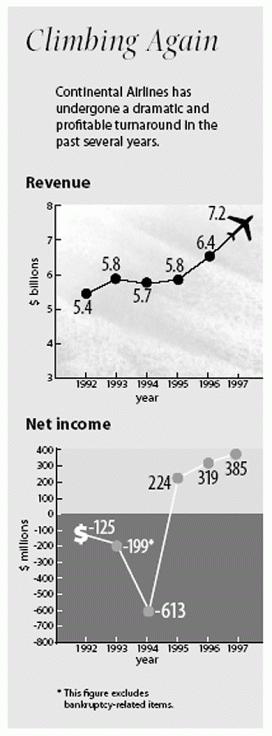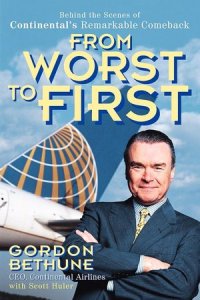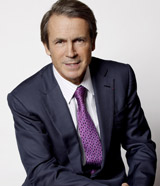The turnaround of continental airlines in the 1980’s is one of the most remarkable stories of the corporate world. The company was set up in 1934 and for decades had been known for quality of its service and the stability and caring of its governance structure. Indeed the CEO Bob Six had actually been CEO of the company from 1936 till 1981. The deregulation of the airline industry by the Carter administration changed all that. Suddenly, Airline companies became caught in a dog fight for market share. In an industry that saw its profits plummeting due to the increase of oil prices and also the lack of barriers to entry in the industry. By the time Gordon Bethune took over in 1994, the company had gone bankrupt already and had gone through 10 leaders in 10 years and looked, to all intents and purposes to be totally doomed.

Summary
The book is a semi biographical outline of how Gordon Bethune became CEO of the company and the changes that he brought in to make it profitable, his results are impressive. In 1994 the company lost $204 million dollars. By 1995 they had made over $200 million; this had increased to $550 million by 1996. The company had then 16 straight quarters of profits. There are many technical and strategic details to how Bethune went about saving the company, in fact the overriding theme is that you get the impression of a CEO who one, enjoyed the aviation industry and 2 : who wanted to save the company rather than to take the best parts of it and then sell it off in a garage sale that had been going on in the industry for the past decade. To some extent, taking over a company when it is in dire straits is perhaps easier than when things are going well. Think of poor Jeff Imelt, and the time it has taken him to establish his reputation as one of the world’s greatest CEOs, having taken over from the highly charismatic jack Welsh who had been voted CEO of the century. Bethune did not have this problem. When he came to the company, it was simply on the verge of extinction and to that extent, any changes would have been accepted by the staff.
 However, his entire strategy was not just about cutting costs, though of course this had to be done. It was about changing the culture and giving a vision to the company. The second chapter begins with a very interesting comment. Bethune describes how he made a significant change on the executive floor of Continental airlines at the Houston headquarters on October 1994. What was that change? He simply opened the door, and made sure that it stayed open. He then set about talking to employees and giving as much information as possible, inviting them up on Fridays to communicate with them, and ensuring that they all understood the vision he had for the company. The climate within Continental had been so bad at that time that one flight attendant had even said (jokingly we hope) “that we wouldn’t be prepared to drink water or a soda on a plane if someone else had opened it for them”. This is hardly conducive to giving a warm and relaxed atmosphere to passengers. Interestingly, Bethune even said that he had to fight for the job and that he was prepared to fight for it. He underlines the fact that, if you want to make a change, you really have to want to and to be prepared to make the sacrifices that go with it. Having created a more open climate, he then set about a four point plan, described as “fly to win, to increase revenues and to deliver good quality. Fund the future to make sure that Continental stopped running into perennial problems due to lack of cash, make reliability a reality, so that they could improve the product and service they were offering, and working together to ensure that a new corporate culture was installed in the company. The results were quite spectacular; in 1994 Continental Airlines was known to be the worst airline in the industry. By 1997, by all measures set by the US government, such as on-time arrival, quality of service, number of baggage losses etc, it had become the best company in the industry.
However, his entire strategy was not just about cutting costs, though of course this had to be done. It was about changing the culture and giving a vision to the company. The second chapter begins with a very interesting comment. Bethune describes how he made a significant change on the executive floor of Continental airlines at the Houston headquarters on October 1994. What was that change? He simply opened the door, and made sure that it stayed open. He then set about talking to employees and giving as much information as possible, inviting them up on Fridays to communicate with them, and ensuring that they all understood the vision he had for the company. The climate within Continental had been so bad at that time that one flight attendant had even said (jokingly we hope) “that we wouldn’t be prepared to drink water or a soda on a plane if someone else had opened it for them”. This is hardly conducive to giving a warm and relaxed atmosphere to passengers. Interestingly, Bethune even said that he had to fight for the job and that he was prepared to fight for it. He underlines the fact that, if you want to make a change, you really have to want to and to be prepared to make the sacrifices that go with it. Having created a more open climate, he then set about a four point plan, described as “fly to win, to increase revenues and to deliver good quality. Fund the future to make sure that Continental stopped running into perennial problems due to lack of cash, make reliability a reality, so that they could improve the product and service they were offering, and working together to ensure that a new corporate culture was installed in the company. The results were quite spectacular; in 1994 Continental Airlines was known to be the worst airline in the industry. By 1997, by all measures set by the US government, such as on-time arrival, quality of service, number of baggage losses etc, it had become the best company in the industry.
The book is a fantastic and very readable outline to how Bethune went about this. For the large part, this involved making employees understand that they were all working together. This included giving bonuses to employees, based on on-time arrivals, but bonuses that were given to the entire staff, not just to certain executives, as has happened in other airline companies. This bonus was not great. It was a mere $65 but it was sent in a cheque so that people would understand immediately that they had received extra money for the hard work they had put in, and could do something special with it. The book gives a great outline to any person taking on a company or department and wants to change a losing culture into a winning one.
Interesting quotes
“When we emerged from bankruptcy in 1993, the company threw a big party – caviar, champagne, the whole works. “Whoopee! We’re not broke! Let’s celebrate.””
“There’s one other lesson here that is small enough to overlook, but you shouldn’t: Don’t be too proud to beg. Use everything at your disposal when you’re trying to resolve a crisis.”
“You can’t afford to run out of cash. All your accounting procedures should distil your numbers in a way that tells you, simply: How much money do you have? Where is it? How does that relate to how much you had yesterday or last week?”
“We had cut our costs so much that we simply had nothing to offer anymore. Our service was lousy, and nobody knew when a plane might land.”
“In February 1995, 80% of our flights landed on time. That put us in fourth place- and, for the first time in years, better than the industry average of 79%.”
“In March we ranked first. More than 83% of our planes landed on time, and nobody did better than that. We were in first place- for the first time in our entire history.”
“Under the old style of management, as symbolised by that authoritarian annual, employees were limited on every side. A passenger with an unusual situation was a dangerous character to be avoided, not a challenge to be resolved.”
“We want employees to use their judgement. And to be honest this scared some of our managers to death. “They’re going to give away the store!” was the basic fear.”
“A similar situation exists with our pilots. Instead of an ironclad rule to take off at the scheduled time, our pilots now have the authority- the responsibility- to take off when it makes sense.”
“A manager’s job, I think is simple. A manager wants to hire the best people for the job: make sure they have the proper training, resources, and support; and then get out of the way.”
“We aren’t in business to save money- we are in business to put out a good product.”
“Changing a corporate culture is a complicated thing.”
“Remember that we ritually burned that employee procedure and policy manual and then had employees come up with a new set of guidelines?”
“That was probably the most important thing we did as far as managers making employees happier.”
“People like to buy into what you’re doing rather than have you force it on them.”
“You can’t win forever unless you excel forever.”
“A company can’t just stay good. It has to keep getting better.”
“The Customer Is Not Always Right, That’s a popular line with my friend Herb Kelleher right now, and it’s an important concept.”
“Businesses fail because they want the right things but measure the wrong things- or they measure the right things the wrong way, so they get the wrong results.”
“Goals and metrics need to be clear to everybody. If the employees don’t know exactly what you’re measuring and exactly what you want, they are not going to invent their own goals and metrics, and these may not be the ones you’d like them to have.”
“We’re a service industry. That means our people work during all the times when everybody else is at home with their families. Like firefighters or police officers, we never stop providing our service, and it becomes even more important during holidays, when more, rather than fewer, people need us.”
See more book reviews:
BOOK REVIEW: “True North: Discover Your Authentic Leadership” by Bill George (2007)
 “There is no such thing as a instant leader.”begins Bill George. Think about the typical CEO of a company. What made his or her leadership style significant to the livelihood of the company, if it was successful to begin with? One quickly realizes that the definition of being a ‘leader’ is not all black and white as numerous leadership studies and archetypes make it out to be. In fact, the former CEO of Medtronic argues that the best leaders are those who do not aim to be leaders, but those who aim to embody leadership throughout the company, called ‘authentic leadership.’
“There is no such thing as a instant leader.”begins Bill George. Think about the typical CEO of a company. What made his or her leadership style significant to the livelihood of the company, if it was successful to begin with? One quickly realizes that the definition of being a ‘leader’ is not all black and white as numerous leadership studies and archetypes make it out to be. In fact, the former CEO of Medtronic argues that the best leaders are those who do not aim to be leaders, but those who aim to embody leadership throughout the company, called ‘authentic leadership.’
BOOK REVIEW: “The Triumph of Emptiness: Consumption, Higher Education, and Work Organization” by Mats Alvesson (2013)
 Review by Philip Warwick
Review by Philip Warwick
Mats Alvesson’s latest work centres on the depiction of three contemporary conditions of modern western society: grandiosity, illusion tricks and zero sum games; principle among these being grandiosity. Alvesson argues that behind the seemingly impressive façades, there is little to show for consumption, economic growth, prosperity or mass higher education. He ends the book with the rather downbeat conclusion… underlying the grandiose society’s illusion tricks is the triumph of emptiness.

















Pingback: BOOK REVIEW: “Confidence : How winning streaks and losing streaks begin and end” by Rosabeth M. Kanter (2004) | GlobalEd